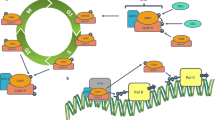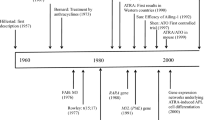Abstract
DNA methylation and BLC-2 are potential therapeutic targets in acute myeloid leukemia (AML). We investigated pharmacologic interaction between the DNA methyltransferase inhibitor 5-azacytidine (5-AZA) and the BCL-2 inhibitor ABT-737. Increased BCL-2 expression determined by reverse phase protein analysis was associated with poor survival in AML patients with unfavorable cytogenetics (n = 195). We found that 5-AZA, which itself has modest apoptotic activity, acts synergistically with ABT-737 to induce apoptosis. The 5-AZA/ABT-737 combination enhanced mitochondrial outer membrane permeabilization, as evidenced by effective conformational activation of BAX and ∆ψm loss. Although absence of p53 limited apoptotic activities of 5-AZA and ABT-737 as single agents, the combination synergistically induced apoptosis independent of p53 expression. 5-AZA down-regulated MCL-1, known to mediate resistance to ABT-737, in a p53-independent manner. The 5-AZA/ABT-737 combination synergistically induced apoptosis in AML cells in seven of eight patients. 5-AZA significantly reduced MCL-1 levels in two of three samples examined. Our data provide a molecular rationale for this combination strategy in AML therapy.





Similar content being viewed by others
References
Yip KW, Reed JC (2008) Bcl-2 family proteins and cancer. Oncogene 27:6398–6406
Kornblau SM, Vu HT, Ruvolo P et al (2000) BAX and PKCα modulate the prognostic impact of BCL2 expression in acute myelogenous leukemia. Clin Cancer Res 6:1401–1409
Oltersdorf T, Elmore SW, Shoemaker AR et al (2005) An inhibitor of BCL-2 family proteins induces regression of solid tumours. Nature 435:677–681
Konopleva M, Contractor R, Tsao T et al (2006) Mechanisms of apoptosis sensitivity and resistance to the BH3 mimetic ABT-737 in acute myeloid leukemia. Cancer Cell 10:375–388
Roberts AW, Seymour JF, Brown JR et al (2012) Substantial susceptibility of chronic lymphocytic leukemia to BCL2 inhibition: results of a phase I study of navitoclax in patients with relapsed or refractory disease. J Clin Oncol 30:488–496
Adams JM (2012) Therapeutic potential of a peptide targeting BCL-2 cell guardians in cancer. J Clin Invest 122:1965–1967
Rice KL, Hormaeche I, Licht JD (2007) Epigenetic regulation of normal and malignant hematopoiesis. Oncogene 26:6697–6714
Silverman LR, Demakos EP, Peterson BL et al (2002) Randomized controlled trial of azacitidine in patients with the myelodysplastic syndrome: a study of the Cancer and Leukemia Group B. J Clin Oncol 20:2429–2440
Fenaux P, Mufti GJ, Hellstrom-Lindberg E et al (2010) Azacitidine prolongs overall survival compared with conventional care regimens in elderly patients with low bone marrow blast count acute myeloid leukemia. J Clin Oncol 28:562–569
Soriano AO, Yang H, Faderl S et al (2007) Safety and clinical activity of the combination of 5-AZAytidine, valproic acid, and all-trans retinoic acid in acute myeloid leukemia and myelodysplastic syndrome. Blood 110:2302–2308
Kojima K, Konopleva M, Samudio IJ et al (2005) MDM2 antagonists induce p53-dependent apoptosis in AML: implications for leukemia therapy. Blood 106:3150–3159
Petitjean A, Mathe E, Kato S et al (2007) Impact of mutant p53 functional properties on TP53 mutation patterns and tumor phenotype: lessons from recent developments in the IARC TP53 database. Hum Mutat 28:622–629
Kojima K, Shimanuki M, Shikami M et al (2008) The dual PI3 kinase/mTOR inhibitor PI-103 prevents p53 induction by Mdm2 inhibition but enhances p53-mediated mitochondrial apoptosis in p53 wild-type AML. Leukemia 22:1728–1736
Kojima K, Duvvuri S, Ruvolo V, Samaniego F, Younes A, Andreeff M (2012) Decreased sensitivity of 17p-deleted chronic lymphocytic leukemia cells to a small molecule BCL-2 antagonist ABT-737. Cancer 118:1023–1031
Grimwade D (2007) Impact of cytogenetics on clinical outcome in AML. In: Karp JE (ed) Acute myeloid leukemia. Humana, Totowa, pp 177–192
Kojima K, McQueen T, Chen Y et al (2011) p53 activation of mesenchymal stromal cells partially abrogates microenvironment-mediated resistance to FLT3 inhibition in AML through HIF-1α-mediated down-regulation of CXCL12. Blood 118:4431–4439
Kornblau SM, Qiu YH, Zhang N et al (2011) Abnormal expression of FLI1 protein is an adverse prognostic factor in acute myeloid leukemia. Blood 118:5604–5612
Tibes R, Qiu YH, Lu Y et al (2006) Reverse phase protein array (RPPA): validation of a novel proteomic technology and utility for analysis of primary leukemia specimens and hematopoetic stem cells (HSC). Mol Cancer Ther 5:2512–2521
Kornblau SM, Tibes R, Qiu YH et al (2009) Functional proteomic profiling of AML predicts response and survival. Blood 113:154–164
Hunyady B, Krempels K, Harta G, Mezey E (1996) Immunohistochemical signal amplification by catalyzed reporter deposition and its application in double immunostaining. J Histochem Cytochem 44:1353–1362
Hu J, He X, Baggerly KA et al (2007) Non-parametric quantification of protein lysate arrays. Bioinformatics 23:1986–1994
Neeley ES, Kornblau SM, Coombes KR, Baggerly KA (2009) Variable slope normalization of reverse phase protein arrays. Bioinformatics 25:1384–1389
Chou TC (2006) Theoretical basis, experimental design, and computerized simulation of synergism and antagonism in drug combination studies. Pharmacol Rev 58:621–681
Kiziltepe T, Hideshima T, Catley L et al (2007) 5-Azacytidine, a DNA methyltransferase inhibitor, induces ATR-mediated DNA double-strand break responses, apoptosis, and synergistic cytotoxicity with doxorubicin and bortezomib against multiple myeloma cells. Mol Cancer Ther 6:1718–1727
van Delft MF, Wei AH, Mason KD et al (2006) The BH3 mimetic ABT-737 targets selective Bcl-2 proteins and efficiently induces apoptosis via Bak/Bax if Mcl-1 is neutralized. Cancer Cell 10:389–399
Chen S, Dai Y, Harada H, Dent P, Grant S (2007) Mcl-1 down-regulation potentiates ABT-737 lethality by cooperatively inducing Bak activation and Bax translocation. Cancer Res 67:782–791
Traina F, Jankowska AM, Visconte V et al. (2011) Impact of molecular mutations on treatment response to hypomethylating agents in MDS [abstract 461]. Blood 118
Walker AR, Metzeler KH, Geyer S (2011) Impact of DNMT3A mutations on clinical response to the hypomethylating agent decitabine in older patients (pts) with acute myeloid leukemia (AML) [abstract 944]. Blood 118
Khan R, Schmidt-Mende J, Karimi M et al (2008) Hypomethylation and apoptosis in 5-azacytidine-treated myeloid cells. Exp Hematol 36:149–157
Bogenberger JM, Shi C-X, Gonzales G et al. (2011) RNAi screening identifies BCL-XL as an erythroid lineage-specific 5-Azacytidine sensitizer while the BCL-2/BCL-XL/BCL-W inhibitor ABT-737 results in more universal sensitization in leukemia cells [abstract 3513]. Blood 118
Rücker FG, Schlenk RF, Bullinger L et al (2012) TP53 alterations in acute myeloid leukemia with complex karyotype correlate with specific copy number alterations, monosomal karyotype, and dismal outcome. Blood 119:2114–2121
Grant support
This study is supported by the National Institutes of Health Lymphoma SPORE (CA136411), P01 “The Therapy of AML” (CA55164), Leukemia SPORE (CA100632), and the Paul and Mary Haas Chair in Genetics (M. Andreeff).
Disclosure of potential conflicts of interest
The authors declare no competing financial interests.
Author information
Authors and Affiliations
Corresponding author
Additional information
Kensuke Kojima and Marina Konopleva contributed equally to this project.
Electronic supplementary material
Below is the link to the electronic supplementary material.
Supplemental Fig. S1
5-AZA, ABT-737 and their combination did not affect levels of BCL-2 family proteins BAX, BAK, BCL-XL, and BCL-2, or p53. Expression of total BAX, BAK, BCL-2, BCL-XL, and p53 in OCI-AML-3 cells treated for 72 h with indicated concentrations of 5-AZA and ABT-737, either as individual agents or in combination. Two membranes were used to detect BCL-2 family proteins, as they exhibit similar protein mass. (DOC 62 kb)
Supplemental Fig. S2
5-AZA and ABT-737 synergistically induce mitochondrial apoptosis in AML cells irrespective of p53 expression. MOLM-13 cells transduced with retroviruses encoding either scrambled shRNA (shC) or p53-specific shRNA (shp53), were treated for 72 h with 250, 500, 1,000, or 2,000 nM 5-AZA and ABT-737, either as individual agents or in combination. The concentration ratio of ABT-737 to 5-AZA was 1:10. Annexin V-positive fractions were measured by flow cytometry. Results are expressed as mean ± SD. (DOC 199 kb)
Supplemental Table S1
Clinical data and mutations in NPM1 and FLT3 (DOC 43 kb)
Supplemental Table S2
Percentages of circulating human CD45+ cells (DOC 33 kb)
Rights and permissions
About this article
Cite this article
Tsao, T., Shi, Y., Kornblau, S. et al. Concomitant inhibition of DNA methyltransferase and BCL-2 protein function synergistically induce mitochondrial apoptosis in acute myelogenous leukemia cells. Ann Hematol 91, 1861–1870 (2012). https://doi.org/10.1007/s00277-012-1537-8
Received:
Accepted:
Published:
Issue Date:
DOI: https://doi.org/10.1007/s00277-012-1537-8




